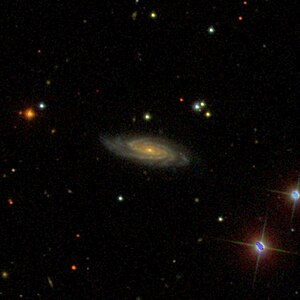NGC 2600
| Galaxy NGC 2600 |
|
|---|---|

|
|
| SDSS recording | |
| AladinLite | |
| Constellation | Big Bear |
|
Position equinox : J2000.0 , epoch : J2000.0 |
|
| Right ascension | 08 h 34 m 45.0 s |
| declination | + 52 ° 42 ′ 56 ″ |
| Appearance | |
| Morphological type | Sb / LINER |
| Brightness (visual) | 14.2 mag |
| Brightness (B-band) | 15.0 mag |
| Angular expansion | 1.2 ′ × 0.4 ′ |
| Position angle | 78 ° |
| Surface brightness | 13.3 mag / arcmin² |
| Physical data | |
| Affiliation | WBL 186-001 |
| Redshift | 0.044961 ± 0.000076 |
| Radial velocity | 13479 ± 23 km / s |
|
Stroke distance v rad / H 0 |
(604 ± 42) · 10 6 ly (185.2 ± 13.0) Mpc |
| history | |
| discovery | Guillaume Bigourdan |
| Discovery date | March 7, 1886 |
| Catalog names | |
| NGC 2600 • UGC 4475 • PGC 24082 • CGCG 263-055 • MCG + 09-14-068 • IRAS F08310 + 5253 • 2MASX J08344506 + 5242566 • GALEX ASC J083445.24 + 524256.6 | |
NGC 2600 is a spiral galaxy with an active nucleus of the Hubble type Sb in the constellation Great Bear in the northern sky . It is an estimated 604 million light years from the Milky Way and about 215,000 light years in diameter .
The galaxies NGC 2602 , NGC 2603 , NGC 2605 , NGC 2606 are located in the same area of the sky .
The object was discovered on March 7, 1886 by the astronomer Guillaume Bigourdan .
